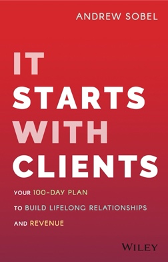
19 Techniques to Create Powerful Client Conversations
My newest (and ninth) book was released today in hardcover–It Starts with Clients: Your 100-Day Plan to Build Lifelong Relationships and Revenue. It’s already number 1 in Customer Relations and number 2 in Business Consulting categories on Amazon.com. It’s my “capstone” book on building clients for life as a trusted advisor–the culmination of 25 years of unique research of great professional-client relationships–as you can see in this playful photo, with the book at the top…
This is a time of deep strains and tough challenges. But it is also a period during which there are extraordinary opportunities to deepen and grow your relationships with clients (and colleagues, family, and friends).
One of the key principles in It Starts with Clients is that great relationships are based on great conversations, not one person showing the other how smart they are and how much they know.
Your most senior clients, in particular, don’t want a lecture on your latest methodology–they want to have a great conversation with you about their most pressing issues.
To help you have better conversations, I’ve developed 19 “conversational techniques,” below.
“When I go to meet with a man,” wrote President Abraham Lincoln, “I spend one-third of my time thinking about what I am going to say, and two-thirds of my time thinking about what he is going to say.” Lincoln certainly had a masterful understanding of human character, and an unusual knack for being able to influence others. (Judging by his language, it also appears many of his meetings were with men, which was probably typical in those days).
His quip highlights a major problem with many highly educated professionals: Sometimes, we are so full of our own thoughts and ideas that we have trouble listening to and engaging the other person. The result is that we don’t get the most out of our conversations.
Sometimes, we are so full of our own thoughts and ideas that we have trouble listening to and engaging the other person. Share on XHere are 19 conversational techniques that will improve your ability to listen to and understand others:
- Synthesizing: “So it seems like there are really three different issues going on here, which are x, y, and z…” Summarizing, which is what many people do when they want to affirm, is boring and tedious to the other person. Synthesizing shows you are listening but goes further and adds value through big-picture thinking.
- Active listening: Interjecting “OK, Uh huh, sure, I see” to communicate that you are paying attention.
- Non-verbal listening: Using your body and eyes to show you are completely focused on the other person. Avoid “tells” that show you aren’t listening, like looking at your smartphone, letting your eyes wander around the room, and so on.
- Echoing*: Repeating the last word spoken. Client: “So as a result, there’s very high attrition.” You: “Attrition.” Client: “Yes, we think it’s well above the industry average. In fact, last year we lost 20% of the sales force.” You: “20%” Client: “Well, some of it was uncontrollable attrition like retirements, but…”
- Disclosure: “I know what you mean—two years ago I also missed a major family event due to a deadline at work…” Sharing your own experiences, in a non-condescending manner, can create a more intimate and meaningful dialog. If you are interested in the psychology of this, look up the “Johari Window,” devised by Ingham and Luft. The idea is that mutual disclosure—not one person talking and the other simply listening—leads to empathy and understanding.
- Open-ended questions: “What would it take to get alignment around this issue?” “What have your past experiences been with outside advisors?” There is research which indicates that successful sales executives use more open-ended than closed-ended questions in the sales process. But setting that aside, open-ended questions draw out the other person and create vibrant conversations.
- Provocative questions: “Why?” “So what?” “Why are you in this business?” “Why do you think you need outside help?” Years ago, I was referred to an expert on newsletter marketing. I called him to explore how I might expand the circulation of my newsletter, Client Loyalty. His first question was, “So Andrew, why do you want more subscribers? Maybe you should have fewer.” At first I was irritated, but then I realized that I had not completely thought through what my goals for the newsletter were. His provocative question made me think.
- Provocative or “turnaround” answers*: Client: “So what can you do for us?” You: “I don’t know” Client: “The CEO is challenging our use of consultants” You: “I don’t blame him.”
- Questions about the meaning of words: Client: “This is a very dysfunctional organization.” You: “What do you mean by ‘dysfunctional?’” Client: “Basically, we want our relationship managers to up their game and stop playing politics.” You: “What does ‘playing politics’ mean in your organization?” Don’t assume you understand exactly what your client means when he or she uses certain terms!
- Questions about the past: “How and when did this start?”
- Questions about the present: “What are you doing now to fix this?” or “What’s the one thing that could really make a difference here?”
- Questions about the future: “If this project succeeds, what would things look like a year from now?”
- Personal questions: “What are your own aspirations in the organization?” “Who have your mentors been?” “What parts of your current role do you wish you could spend more time on?” Don’t kid yourself—every client gains some personal value from working with us.
- Questions about feelings: “How did you feel about that decision?” Usually, we ask about thoughts—“What do you think?” Asking about feelings can tap into a whole new aspect of the issue.
- Use of humor: Appropriate jokes or quips, self-deprecation, “break the ice” humor, and so on.
- Not answering: “I don’t know your company well enough to answer that. I can tell you what I’ll be looking for, however”; “I don’t know. Let me get back to you.” Saying “I don’t know” can actually build, not erode, trust.
- Questions about the question: “Let me make sure I understand your question: Are you asking if it’s a good idea or if it’s feasible?” Or, “I’m curious about why you’re asking me that…” (Note: be careful not to overuse this latter technique, which can come across as contrived or evasive if used too often or at the wrong moment).
- Questions about what is missing: “Is there anything I haven’t asked about that you think is relevant to this issue?
- Letting the client answer provocative questions: You don’t always have to have the answer! For example: You’re presenting to a group of client executives. Someone asks the question, “So you’ve demonstrated that our costs are 20% over the benchmark. I just don’t believe that.” You look at the person attentively, let your eyes wander to the other meeting participants, and remain silent for 3-5 seconds. Given the opening (your silence), another executive in the audience may very well jump in: “Oh come on, we’ve known this for years. That’s why our operating margins are so bad.” All of a sudden, your clients are having a healthy debate among themselves, and metaphorically you’re on the same side of the table. This has happened to me many, many times. I learned this technique as a young consultant when I was asked a tough question in front of the entire senior leadership team of a major corporation. As I paused—a bit longer than I wanted—to think about my answer, one of the executives jumped in and I didn’t have to say a word!
Try some of these techniques in your conversations with clients—or with anyone else 3wa matters in your life. They may well help you to have deeper and more interesting discussions.
*****
My newest book is now available. It’s called It Starts with Clients: Your 100-Day Plan to Build Lifelong Relationships and Revenue. It’s the only guide you’ll ever need to grow your client base in any market conditions. Buy it here and download your free Client Growth Guide.
*Thanks to my friend and mentor Alan Weiss for numbers 4 and 8.

